Monitoring Rock Desert Formation Caused by Ice–Snow Melting in the Qinghai-Tibet Plateau Using an Optimized Remote Sensing Technique: A Case Study of Yushu Prefecture
Abstract
:1. Introduction
2. Research Area and Data Source
2.1. Overview of the Study Area
2.2. Data Source and Preprocessing
3. Classification System of Rock Desert in Ice–Snow Melting Area
4. Methods
4.1. Ice–Snow Melting Area Extraction
4.1.1. Snow and Ice Extraction Based on S3 Snow Index Model and NDVI Method
4.1.2. Snow Line Extraction
4.1.3. Determination of Ice–Snow Melting Area in Yushu Prefecture in the Last 30 Years
4.2. Rock Desert Classification Index
4.2.1. Surface Roughness
4.2.2. Modified Bare Soil Index (MBI)
4.2.3. Spectral Reflectivity
4.2.4. Textural Features
4.3. Multi-Index Fusion Rock Desert Classification
4.3.1. Multi-Index Factor Compound Analysis (MIFCA)
4.3.2. Multi-Index Principal Component Analysis (MIPCA)
4.3.3. Object-Oriented Classification (OOC)
5. Processes and Results
5.1. Snow and Ice, Snow Line and Ice–Snow Melting Area
5.2. Classification Results of Rock Desert in Ice–Snow Melting Area
5.3. Results of Accuracy Verification
5.3.1. Accuracy Verification of Ice–snow Melting Area
5.3.2. Accuracy Verification of Rock Desert
5.4. Composition Structure and Vertical Distribution of Rock Desert Types
6. Discussion
6.1. Ways to Improve the Accuracy of Remote Sensing Extraction of Rock Desert
6.2. How to Identify Rock Desert in Ice–Snow Melting Area and Rockdesert in Dry Area by Remote Sensing?
6.3. Dynamic Change of Rock Desert Response after Melting Due to Global Climate Change
7. Conclusions
- According to the accuracy evaluation of various methods for extracting rock desert in the ice–snow melting area, a fast and efficient method of multi-index fusion for the classification of rock desert in the ice–snow melting area of Qinghai-Tibet Plateau is proposed. The rock desert in ice–snow melting area is extracted by seven schemes, including multi-index factor compound analysis, multi-index principal component analysis, object-oriented classification and four combinations of the three methods. The multi-index factor compound analysis and object-oriented classification compound method have the highest overall accuracy of 83.59% and Kappa coefficient of 0.79. The fusion of the two methods can not only utilize the spectral information and texture features of remote sensing images, but also integrate the information of each index. The fusion method can provide a fast and efficient reference scheme for extracting rock desert in the ice–snow melting area of Qinghai-Tibet Plateau.
- The fusion of two single methods with higher accuracy can further improve the total accuracy. If a single method with lower accuracy is involved in the multi-method fusion, the accuracy of the method with lower accuracy can be improved. In the single method classification, the object-oriented classification method has the highest accuracy, followed by the multi-index factor compound analysis method, and the multi-index principal component analysis method has the lowest accuracy. Kappa coefficients are 0.74, 0.71 and 0.55, respectively, and each method can reliably extract rock desert types. In the multi-method fusion, the multi-index factor compound analysis and the object-oriented classification compound method have the highest classification accuracy among the seven methods. Compared with the object-oriented extraction, the single method with highest accuracy, the overall accuracy is improved by 4.10%, and the Kappa coefficient is improved by 0.05. In the multi-method fusion involving principal component analysis, the classification accuracy is improved to some extent, but it is lower than that of the method with higher accuracy, especially in the fusion of the two methods, and the accuracy of bare stone is still not high.
- Yushu Prefecture of Qinghai-Tibet Plateau has a large amount of ice–snow melting, and the rock desert is widely distributed in this area. In the past 30 years, the average snow line value has risen by 117.70 m, and the ice and snow has melted by 1451.04 km2, accounting for 53.78% of the ice–snow area. The ice–snow melting area accounted for 53.78% (1451.04 km2) of the ice–snow areas. The Yogu Zonglie Basin in the northern foot of Bayan Har has almost completely melted, while the area near Bukadaban Peak in the middle of Kunlun Mountain has incompletely melted. The area of bare rock and bare stone in the desert is 925.10 km2, accounting for 63.77% of the total area of the ice–snow melting area. Bare sand and bare soil area account for 30.27% of the total area of the ice–snow melting area. There are different types of rock deserts in the melting area, which have no obvious characteristics in spatial distribution, but a certain regularity in vertical gradient. Bare rock and bare stone are located at the highest level, bare gravel is the transition layer, and bare sand and bare soil are located at the lowest level.
Author Contributions
Funding
Data Availability Statement
Acknowledgments
Conflicts of Interest
References
- Bao, W.; Liu, S.; Wu, K.; Wang, R.; Jiang, Z. A method for extracting snow line altitude based on MODIS snow product. J. Glaciol. Geocryol. 2017, 39, 259–272. [Google Scholar]
- Qin, D.; Zhou, B.; Xiao, C. Progress in studies of cryospheric changes and their impacts on climate of China. Aicta Meteorol. Sin. 2014, 72, 869–879. [Google Scholar] [CrossRef]
- Yao, T. Glacier changes and their effects on lakes in the southern Qinghai-Tibet Plateau. Chin. Sci. Bull. 2010, 55, 1749. [Google Scholar] [CrossRef] [Green Version]
- Dai, L.; Che, T.; Ding, Y.; Hao, X. Evaluation of snow cover and snow depth on the Qinghai–Tibetan Plateau derived from passive microwave remote sensing. Cryosphere 2017, 11, 1933–1948. [Google Scholar] [CrossRef] [Green Version]
- Zhang, P.; Zhang, Z.; Li, X.; Wang, Y.; Yu, J.; Huang, Y. Desertification remote sensing information extraction from Qinghai-Tibet Plateau and evolution analysis. Arid. Land Geogr. 2006, 19, 710–717. [Google Scholar]
- Li, Q.; Zhang, C.; Zhou, N.; Shen, Y.; Wu, Y.; Zou, X.; Li, J.; Jia, W.; Wang, X. Spatial Distribution of Aeolian Desertification on the Qinghai-Tibet Plateau. J. Desert Res. 2018, 38, 690–700. [Google Scholar]
- Zhang, R. Glacier change and eco-geological environment response in Tibetan Plateau. Geol. Surv. China 2016, 3, 46–50. [Google Scholar]
- Lv, A.; Zhou, L.; Zhu, W. The Remote Sensing based Dynamic Monitoring of Land Desertification in Qinghai Province. Remote Sens. Technol. Appl. 2014, 29, 803–811. [Google Scholar]
- Zhang, B.; Zhou, W.; Zhang, F. Remote sensing monitoring and driving force analysis of land degradation in Qinghai Province from 1999 to 2018. Bull. Soil Water Conserv. 2020, 40, 120–128. [Google Scholar]
- Yu, H.; Zhang, Z.; Zhang, P.; Yu, J. Monitoring of Land Desertification in Tibet Based on RS. J. Earth Sci. Environ. 2007, 3, 316–320. [Google Scholar]
- Feng, J.; Wang, T. Remote Sensing and GIS Analyses of Sand Desertification in the Source Region of the Yellow River. Bull. Soil Water Conserv. 2008, 28, 116–120. [Google Scholar]
- La, B.; Zhaxi, O.; Baima, Y.; Dunyu, D. Study on Remote Sensing Monitoring of Desertification in Tibet Based on MODIS Data. Meteorol. Environ. Sci. 2019, 42, 39–46. [Google Scholar]
- Kargel, J.S. Compositional controls on the geological behavior of icy satellites, and a call for more lab data. Am. Geophys. Union Fall Meet. 2006, 2006, P42B-03. [Google Scholar]
- Jawak, S.; Joshi, M.; Luis, A.; Pandit, P.H.; Somadas, A.T. Mapping velocity of the potsdam glacier, east antarctica using landsat-8 data. Int. Arch. Photogramm. Remote Sens. Spat. Inf. Sci. 2019, 13, 1753–1757. [Google Scholar] [CrossRef] [Green Version]
- Spergel, J.J.; Kingslake, J.; Creyts, T.; Wessem, M.; Fricker, H. A Surface meltwater drainage and ponding on Amery Ice Shelf, East Antarctica, 1973–2019. J. Glaciol. 2021, 67, 1–14. [Google Scholar] [CrossRef]
- Saito, A.; Yamazaki, T. Characteristics of Spectral Reflectance for Vegetation Ground Surfaces with Snow-cover; Vegetation Indices and Snow Indices. J. Jpn. Soc. Hydrol. Water Resour. 2009, 12, 28–38. [Google Scholar] [CrossRef] [Green Version]
- Yadav, B.C.; Jain, K. Fractional Snow/Non-Snow Cover Mapping through Incorporation of Thermal Band in Snow Index Design. Int. J. Geosci. 2017, 8, 1404–1416. [Google Scholar] [CrossRef] [Green Version]
- Gevaert, A.I.; Miralles, D.G.; Jeu, R.; Schellekens, J.; Dolman, A.J. Soil Moisture-Temperature Coupling in a Set of Land Surface Models. J. Geophys. Res. Atmos. 2017, 123, 1481–1498. [Google Scholar] [CrossRef]
- Ran, Y.; Li, X.; Cheng, G.; Nan, Z.; Che, J.; Sheng, Y.; Wu, Q.; Jin, H.; Luo, D.; Tang, Z.; et al. Mapping the permafrost stability on the Tibetan Plateau for 2005–2015. Sci. China Earth Sci. 2021, 64, 62–79. [Google Scholar] [CrossRef]
- Sun, Y.; Zhang, L.; Lu, S.; Liu, H. Method for monitoring daily snow cover based on dynamic NDSI thresholds. J. Geo-Inf. Sci. 2020, 22, 298–307. [Google Scholar]
- Jia, W.; Gao, X.; Yang, Y.; Zhang, W.; Yang, L.; Tian, C. Inversion of Spatial Distribution Pattern of Topsoil Total Nitrogen Contents in Sanjiangyuan Regions Based on OLI Images. Arid. Zone Res. 2015, 32, 890–895. [Google Scholar]
- Hao, Y.; Feng, S.; Yu, Y.; Guo, L. Analysis of Ecological Capacity of Yushu Tibetan Autonomous Prefecture in Qinghai Province. Territ. Nat. Resour. Study 2017, 3, 45–49. [Google Scholar]
- Encyclopedia of Geology Office of the Ministry of Geology and Mineral Resources. Encyclopedia of Geology; Geological Publishing House: Beijing, China, 2005; Volume 119. [Google Scholar]
- Shimamura, Y.; Izumi, T.; Matsuyama, H. Evaluation of a useful method to identify snow-covered areas under vegetation—Comparisons among a newly proposed snow index, normalized difference snow index, and visible reflectance. Int. J. Remote Sens. 2006, 27, 4867–4884. [Google Scholar] [CrossRef]
- Kour, R.; Patel, N.; Krishna, A.P. Development of a new thermal snow index and its relationship with snow cover indices and snow cover characteristic indices. Arab. J. Geosci. 2015, 83, 101–112. [Google Scholar] [CrossRef]
- Sun, Z.; Liu, Z.; Qiu, D. Methods of extracting snow cover information based on HJ–1B data: A case of the Juntanghu watershed. Arid. Land Geogr. 2012, 35, 125–132. [Google Scholar]
- Yue, X.; Li, Z.; Zhao, J.; Li, H.; Wang, L. Changes in the End-of-Summer Snow Line Altitude of Summer-Accumulation-Type Glaciers in the Eastern Tien Shan Mountains from 1994 to 2016. Remote Sens. 2021, 13, 1080. [Google Scholar] [CrossRef]
- Wang, X.; Tang, Z.; Wang, J.; Wang, X.; Wei, J. Monitoring of snowline altitude at the end of melting season in High Mountain Asia based on MODIS snow cover products. Acta Geogr. Sin. 2021, 75, 470–484. [Google Scholar]
- Tang, Z.; Wang, J.; Li, H.; Liang, J.; Li, C.; Wang, X. Extraction and assessment of snowline altitude over the Tibetan plateau using MODIS fractional snow cover data (2001 to 2013). J. Appl. Remote Sens. 2014, 8, 084689. [Google Scholar] [CrossRef]
- Deng, G.; Tang, Z.; Hu, G.; Wang, J.; Sang, G.; Li, J. Spatiotemporal Dynamics of Snowline Altitude and Their Responses to Climate Change in the Tienshan Mountains, Central Asia, during 2001–2019. Sustainability 2021, 13, 3992. [Google Scholar] [CrossRef]
- Smith, M.W. Roughness in the Earth Sciences. Earth-Sci. Rev. 2014, 136, 202–225. [Google Scholar] [CrossRef]
- Gómez, J.A.; Vanderlinden, K.; Nearing, M.A. Spatial variability of surface roughness and hydraulic conductivity after disk tillage: Implications for runoff variability. J. Hydrol. 2005, 311, 143–156. [Google Scholar] [CrossRef]
- Whicker, J.J.; Breshears, D.D.; Wasiolek, P.T.; Kirchner, T.B.; Rodgers, J.C. Temporal and spatial variation of episodic wind erosion in unburned and burned semiarid shrubland. J. Environ. Qual. 2002, 31, 599–612. [Google Scholar] [CrossRef] [PubMed] [Green Version]
- Zeng, Z.; Yang, B.; Fan, J.; Liu, F.; Jing, Y. Calculating Landscape Surface Area based on the Geology Significance of the Surface Roughness. Remote Sens. Technol. Appl. 2014, 29, 846–852. [Google Scholar]
- Nguyen, C.T.; Chidthaisong, C.; Diem, P.K.; Huo, L.Z. A Modified Bare Soil Index to Identify Bare Land Features during Agricultural Fallow-Period in Southeast Asia Using Landsat 8. Land 2021, 10, 231. [Google Scholar] [CrossRef]
- Wang, Z.; Du, B.; Zhang, L.; Zhang, L. Based on Texture Feature and Extend Morphological Profile Fusion for Hyperspectral Image Classification. Acta Photonica Sin. 2014, 4, 122–129. [Google Scholar]
- Yao, A.; Cao, X.; Feng, Y. Remote-sensing model for estimating the size of Gobi surface gravel based on principal components analysis. J. Desert Res. 2014, 34, 1215–1221. [Google Scholar]
- Zhou, R.; Xiong, Y.; Wang, N.; Wang, X. Coupling Degree Evaluation of China’s Internet Financial Ecosystem Based on Entropy Method and Principal Component Analysis. J. Syst. Sci. Inf. 2019, 7, 399–421. [Google Scholar] [CrossRef]
- Perrin, G.; Soize, C.; Duhamel, D.; Funfschilling, C. Karhunen-Loeve expansion revisited for vector-valued random fields: Scaling, errors and optimal basis. J. Comput. Phys. 2013, 242, 607–622. [Google Scholar] [CrossRef] [Green Version]
- Oreti, L.; Giuliarelli, D.; Tomao, A.; Barbati, A. Object oriented classification for mapping mixed and pure forest stands using very-high resolution imagery. Remote Sens. 2021, 13, 2508. [Google Scholar] [CrossRef]
- Ma, W.; Jia, W.; Su, P.; Feng, X.; Liu, F.; Wang, J. Mapping Highland Barley on the Qinghai–Tibet Combing Landsat OLI Data and Object-Oriented Classification Method. Land 2021, 10, 1022. [Google Scholar] [CrossRef]
- Sun, Z.; Guo, H.; Li, X.; Lu, L. Estimating urban impervious surfaces from Landsat-5 TM imagery using multi-layer perceptron neural network and support vector machine. J. Appl. Remote Sens. 2011, 17, 913–927. [Google Scholar]
- Kong, Y.; Jing, M. Research of the Classification Method Based on Confusion Matrixes and Ensemble Learning. Comput. Eng. Sci. 2012, 34, 111–117. [Google Scholar]
- McCallum, I.; Obersteiner, M.; Nilsson, S.; Shvidenko, A. A Spatial Comparison of Four Satellite Derived 1km Global Land Cover Datasets. Int. J. Appl. Earth Obs. Geoinf. 2006, 8, 246–255. [Google Scholar] [CrossRef]
- Chen, J.; Ma, L.; Chen, X.; Rao, Y. Research progress of spectral mixture analysis. J. Remote Sens. 2016, 20, 1102–1109. [Google Scholar]
- Jia, W.; Wang, J.; Shi, P.; Ma, W. The Progress and Prospect of Remote Sensing Monitoring of Rocky Desert Dynamic Changes in the Ice and Snow Melting Area of the Qinghai-Tibet Plateau. J. Geo-Inf. Sci. 2021, 23, 1715–1727. [Google Scholar]

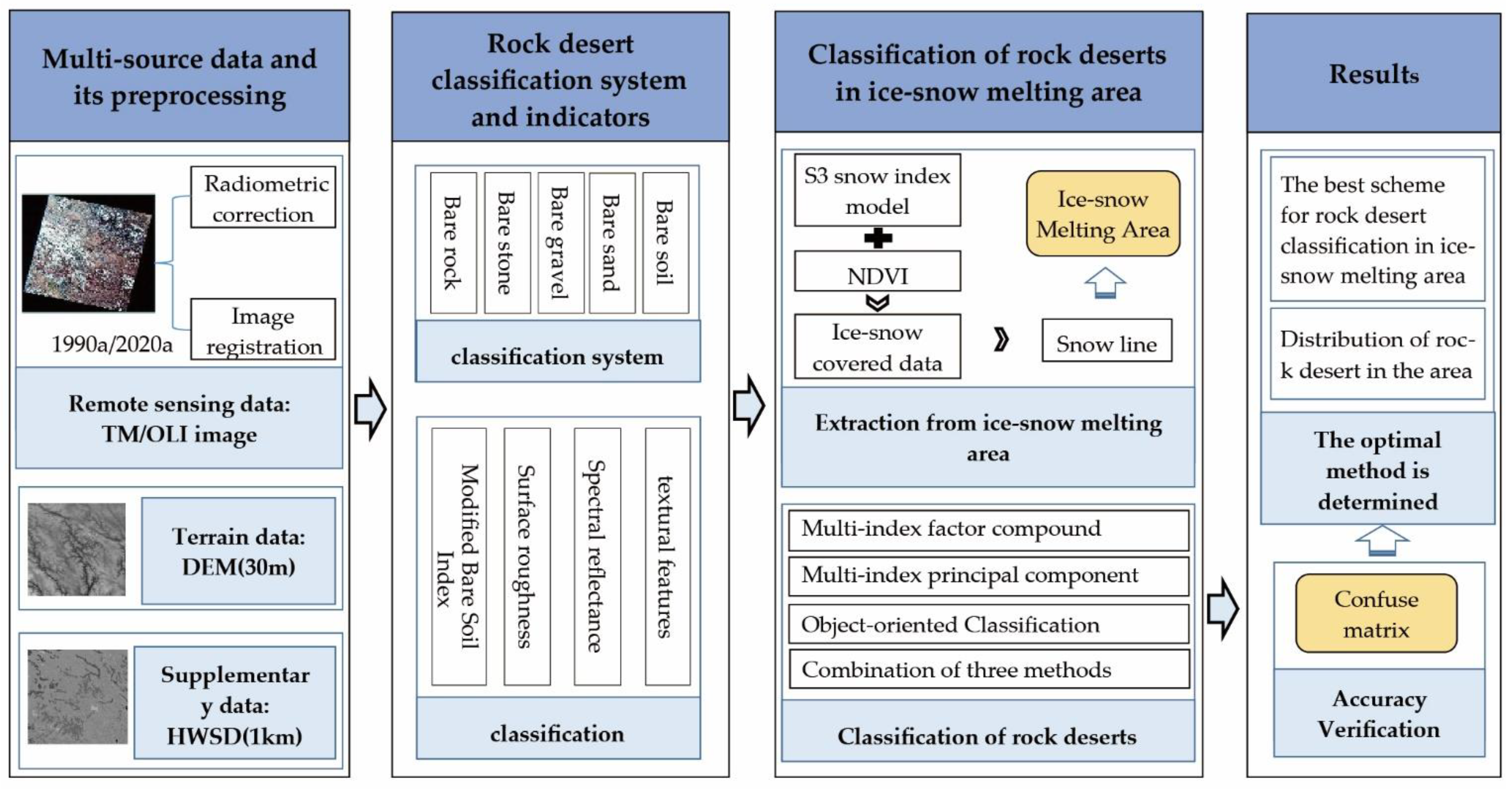
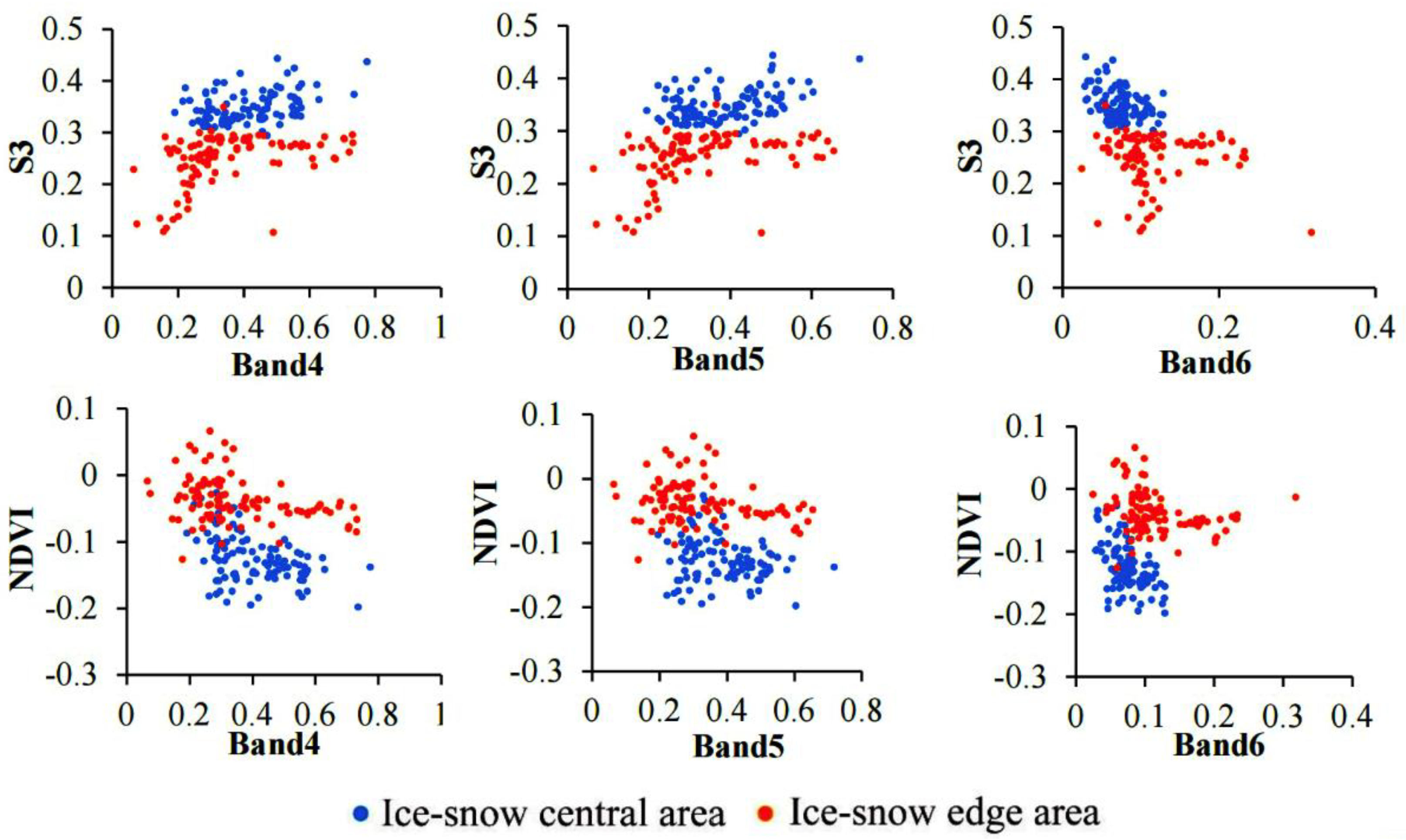

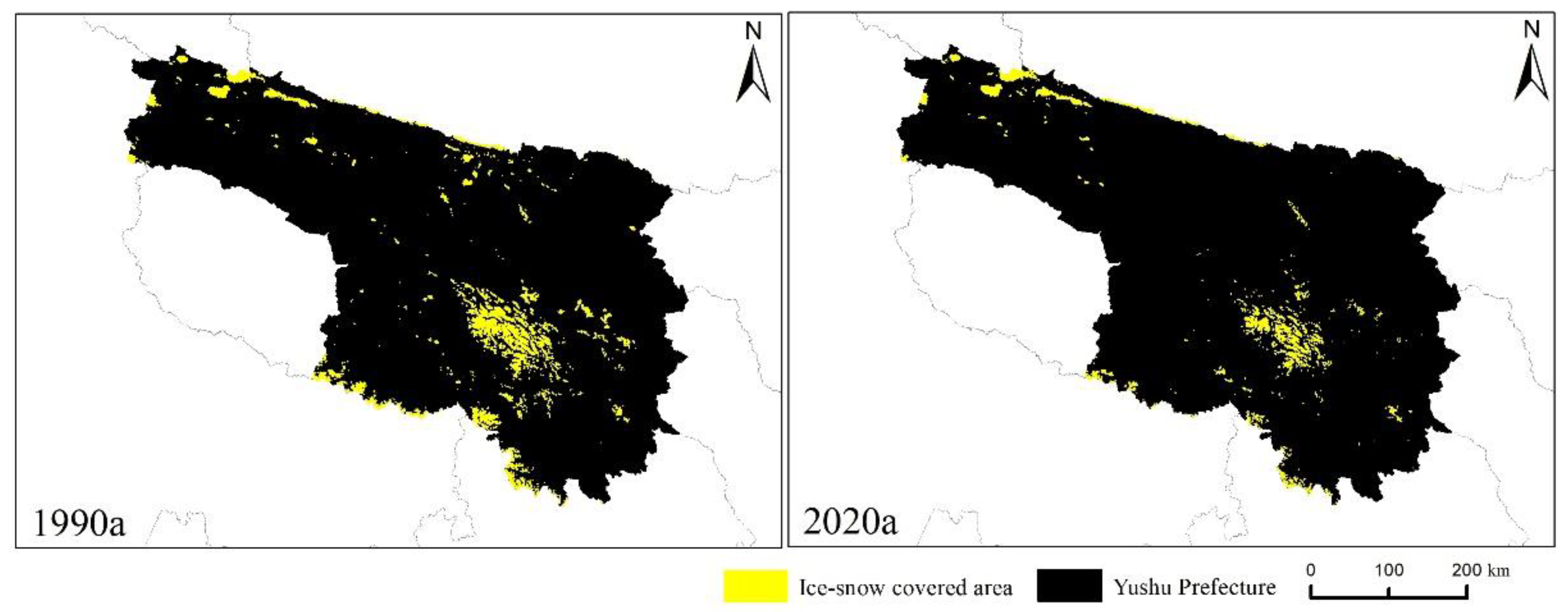
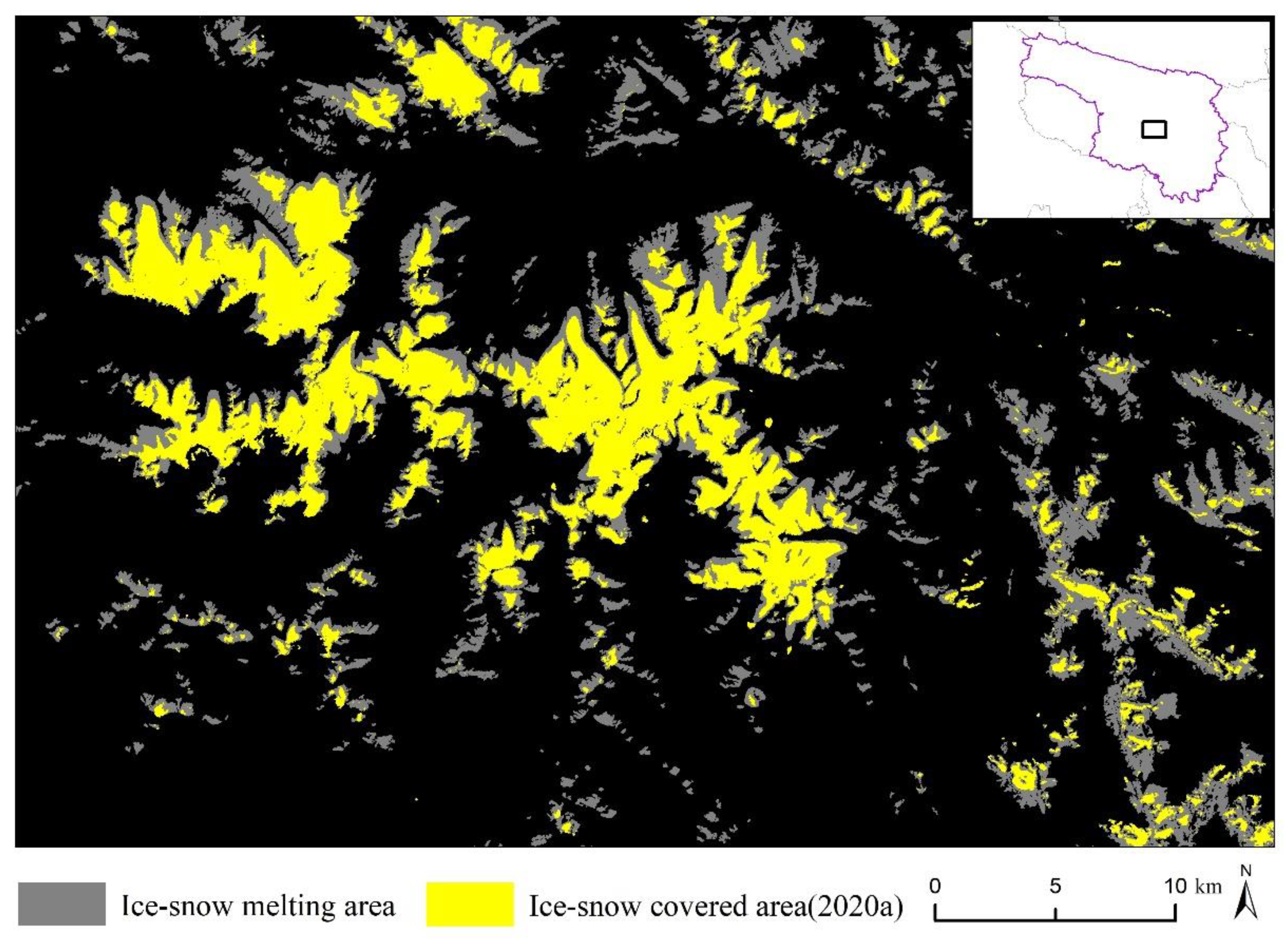

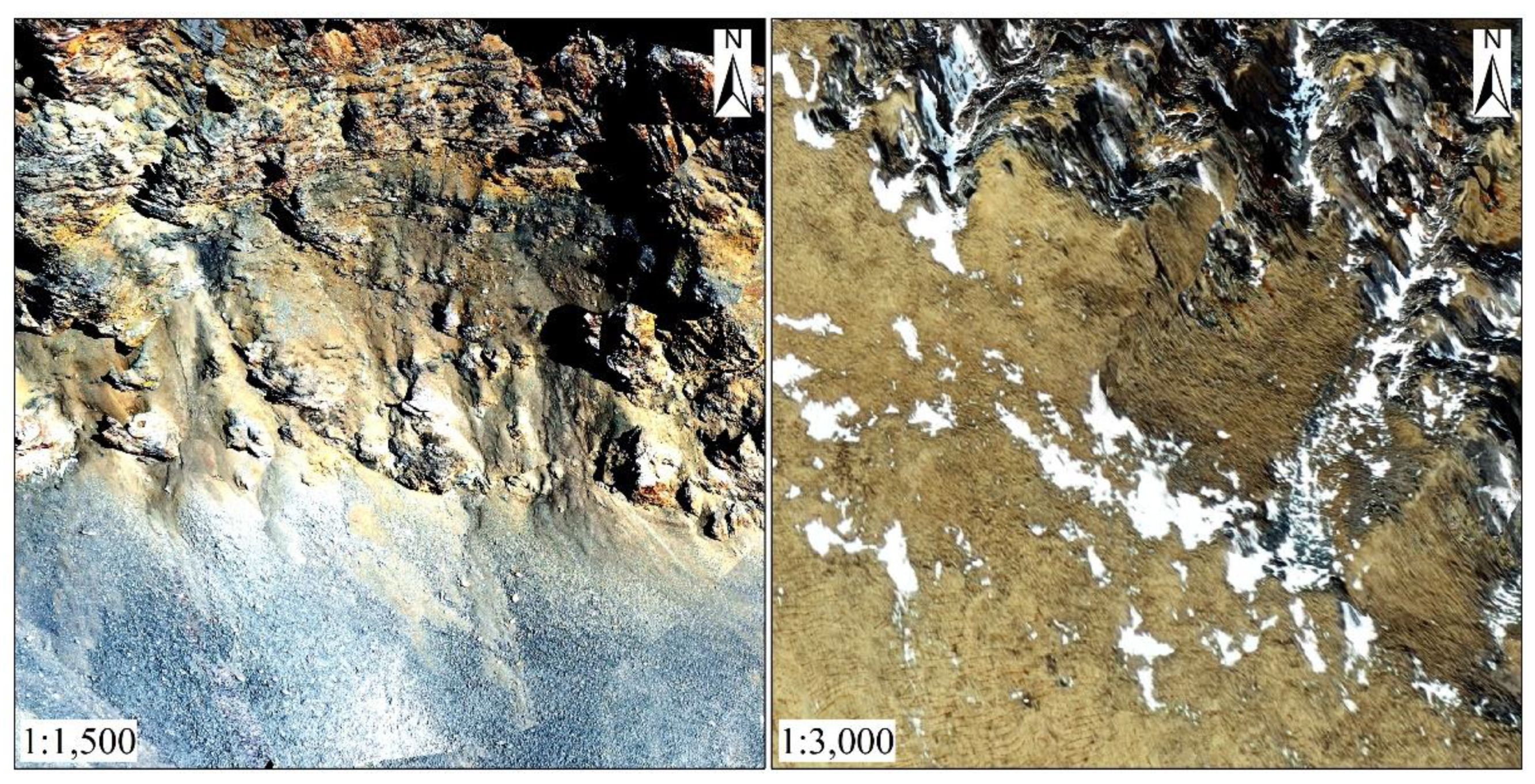
| Path/Row | TM Image Date | OLI Image Date | Path/Row | TM Image Date | OLI Image Date |
|---|---|---|---|---|---|
| 134/036 | 1990/08/30 | 2020/09/17 | 136/038 | 1989/06/22 | 2019/06/25 |
| 134/037 | 1990/08/30 | 2019/07/29 | 137/035 | 1990/09/04 | 2020/09/22 |
| 134/038 | 1992/09/04 | 2020/09/01 | 137/036 | 1990/09/04 | 2020/09/22 |
| 135/035 | 1990/08/21 | 2019/07/04 | 137/037 | 1990/07/02 | 2020/09/22 |
| 135/036 | 1992/07/09 | 2018/07/17 | 138/035 | 1991/09/14 | 2019/08/10 |
| 135/037 | 1988/08/15 | 2018/07/17 | 138/036 | 1991/09/30 | 2019/09/27 |
| 135/038 | 1988/08/15 | 2020/10/10 | 139/035 | 1990/08/17 | 2020/07/18 |
| 136/035 | 1990/08/28 | 2020/08/30 | 139/036 | 1989/07/29 | 2020/07/18 |
| 136/036 | 1990/08/28 | 2019/07/27 | 140/035 | 1991/09/28 | 2019/09/25 |
| 136/037 | 1991/09/16 | 2020/08/30 |
| Code | Category | Surface Landscape Features | Photos |
|---|---|---|---|
| 1 | Bare rock | After ice–snow melting, rock bedding can be seen locally in mountainous areas where bedrock is exposed, mostly in areas where snow and ice have just melted. It is distributed in the upper part of the melting area. |  |
| 2 | Bare stone | The clastic stage dominated by mechanical crushing of bare rock is the initial stage of bedrock weathering, and the physical weathering is the main stage, in which rocks and cuttings are formed by decomposed bedrock. |  |
| 3 | Bare gravel | This surface is composed of coarse sand and gravel, with no bedrock exposed, few fine particles and no soil development. |  |
| 4 | Bare sand | This surface is composed of aeolian sand, and is the product of further weathering of loose sediments or bedrock. |  |
| 5 | Bare soil | The surface layer is soil, not covered by vegetation, and is mainly composed of fine soil, with high clay content. It is mostly distributed at the bottom of the melting area. |  |
| Level-1 Indicators | Level-2 Indicators | Weight |
|---|---|---|
| Surface roughness | Surface roughness | 0.1037 |
| Spectral reflectance | Band1 | 0.1981 |
| Band2 | 0.1966 | |
| Band3 | 0.1954 | |
| Band4 | 0.1978 | |
| MBI | MBI | 0.1082 |
| Coefficient of Regression Equation | Coefficient Value | Standard Error | p-Values |
|---|---|---|---|
| Constant | 1.171 | 0.010 | 0.000 |
| PC1 | −0.017 | 0.010 | 0.003 |
| PC2 | −0.030 | 0.035 | 0.037 |
| PC3 | −0.373 | 0.102 | 0.000 |
| PC4 | 0.805 | 0.369 | 0.030 |
| PC5 | −0.365 | 0.342 | 0.026 |
| Type | Producer’s Accuracy (Pixels) | User’s Accuracy (Pixels) | Producer’s Accuracy (%) | User’s Accuracy (%) | Overall Accuracy (%) | Kappa Coefficient |
|---|---|---|---|---|---|---|
| Ice and snow area | 108/114 | 108/116 | 94.74 | 93.10 | 93.86 | 0.88 |
| Rock desert area | 106/114 | 106/112 | 92.98 | 94.64 |
| Methods | Types of Rock Desert | Producer’s Accuracy (Pixels) | User’s Accuracy (Pixels) | Producer’s Accuracy (%) | User’s Accuracy (%) | Overall Accuracy (%) | Kappa Coefficient |
|---|---|---|---|---|---|---|---|
| MIFCA | Bare rock | 32/42 | 32/42 | 76.19 | 76.19 | 76.92 | 0.71 |
| Bare stone | 37/51 | 37/48 | 72.55 | 77.08 | |||
| Bare gravel | 23/29 | 23/31 | 79.31 | 74.19 | |||
| Bare sand | 23/31 | 23/32 | 74.19 | 71.88 | |||
| Bare soil | 35/42 | 35/45 | 83.33 | 83.33 | |||
| MIPCA | Bare rock | 27/42 | 27/44 | 64.29 | 61.36 | 64.62 | 0.55 |
| Bare stone | 29/51 | 29/49 | 56.86 | 59.18 | |||
| Bare gravel | 20/29 | 20/27 | 68.96 | 74.07 | |||
| Bare sand | 22/31 | 22/39 | 70.97 | 56.41 | |||
| Bare soil | 28/42 | 28/36 | 66.67 | 77.78 | |||
| OOC | Bare rock | 34/42 | 34/42 | 80.95 | 80.85 | 79.49 | 0.74 |
| Bare stone | 40/51 | 40/50 | 78.43 | 80.00 | |||
| Bare gravel | 25/29 | 25/31 | 86.21 | 80.65 | |||
| Bare sand | 23/31 | 23/31 | 74.19 | 74.19 | |||
| Bare soil | 33/42 | 33/41 | 78.57 | 80.49 | |||
| MIFCA and MIPCA | Bare rock | 30/42 | 30/42 | 71.43 | 71.43 | 70.26 | 0.63 |
| Bare stone | 32/51 | 32/45 | 62.75 | 71.11 | |||
| Bare gravel | 22/29 | 22/34 | 75.85 | 64.71 | |||
| Bare sand | 22/31 | 22/36 | 70.97 | 61.11 | |||
| Bare soil | 31/42 | 31/38 | 73.81 | 81.58 | |||
| MIFCA and OOC | Bare rock | 36/42 | 36/41 | 85.71 | 87.81 | 83.59 | 0.79 |
| Bare stone | 42/51 | 42/50 | 82.25 | 84.00 | |||
| Bare gravel | 25/29 | 25/32 | 86.21 | 78.13 | |||
| Bare sand | 26/31 | 26/34 | 83.87 | 76.47 | |||
| Bare soil | 34/42 | 34/38 | 80.85 | 89.47 | |||
| MIPCA and OOC | Bare rock | 32/42 | 32/46 | 76.19 | 69.57 | 72.82 | 0.66 |
| Bare stone | 32/51 | 32/46 | 62.75 | 69.57 | |||
| Bare gravel | 24/29 | 24/32 | 72.76 | 75.00 | |||
| Bare sand | 24/31 | 24/34 | 77.42 | 70.59 | |||
| Bare soil | 30/42 | 30/37 | 71.43 | 81.08 | |||
| MIFCA and MIPCA and OOC | Bare rock | 34/42 | 34/42 | 80.95 | 80.95 | 78.97 | 0.73 |
| Bare stone | 38/51 | 38/53 | 74.51 | 71.70 | |||
| Bare gravel | 24/29 | 24/28 | 82.76 | 85.71 | |||
| Bare sand | 25/31 | 25/35 | 80.65 | 71.43 | |||
| Bare soil | 33/42 | 33/37 | 78.57 | 89.19 |
| Bare Rock | Bare Stone | Bare Gravel | Bare Sand | Bare Soil | Total | |
|---|---|---|---|---|---|---|
| Area/km2 | 453.62 | 471.48 | 86.43 | 186.68 | 252.42 | 1450.63 |
| Proportion/% | 31.27 | 32.50 | 5.96 | 12.87 | 17.40 | 100.00 |
Publisher’s Note: MDPI stays neutral with regard to jurisdictional claims in published maps and institutional affiliations. |
© 2022 by the authors. Licensee MDPI, Basel, Switzerland. This article is an open access article distributed under the terms and conditions of the Creative Commons Attribution (CC BY) license (https://creativecommons.org/licenses/by/4.0/).
Share and Cite
Jia, W.; Ma, W.; Shi, P.; Wang, J.; Su, P. Monitoring Rock Desert Formation Caused by Ice–Snow Melting in the Qinghai-Tibet Plateau Using an Optimized Remote Sensing Technique: A Case Study of Yushu Prefecture. Remote Sens. 2022, 14, 570. https://doi.org/10.3390/rs14030570
Jia W, Ma W, Shi P, Wang J, Su P. Monitoring Rock Desert Formation Caused by Ice–Snow Melting in the Qinghai-Tibet Plateau Using an Optimized Remote Sensing Technique: A Case Study of Yushu Prefecture. Remote Sensing. 2022; 14(3):570. https://doi.org/10.3390/rs14030570
Chicago/Turabian StyleJia, Wei, Weidong Ma, Peijun Shi, Jing’ai Wang, and Peng Su. 2022. "Monitoring Rock Desert Formation Caused by Ice–Snow Melting in the Qinghai-Tibet Plateau Using an Optimized Remote Sensing Technique: A Case Study of Yushu Prefecture" Remote Sensing 14, no. 3: 570. https://doi.org/10.3390/rs14030570





